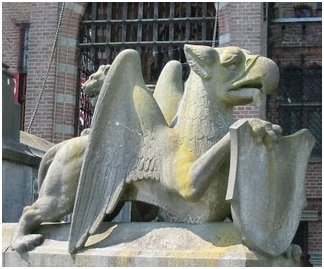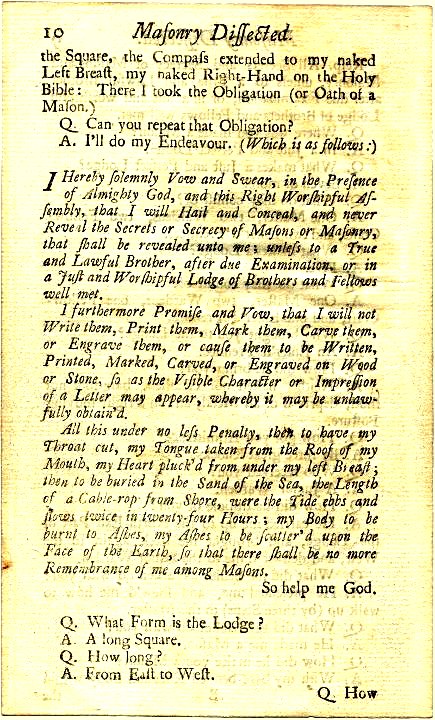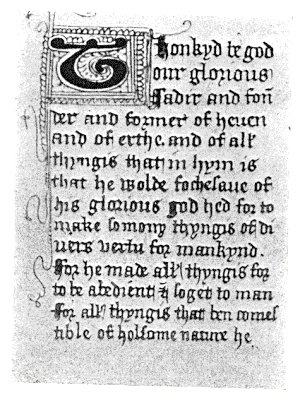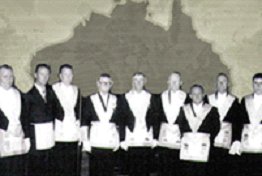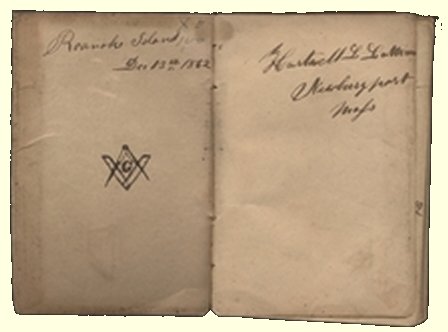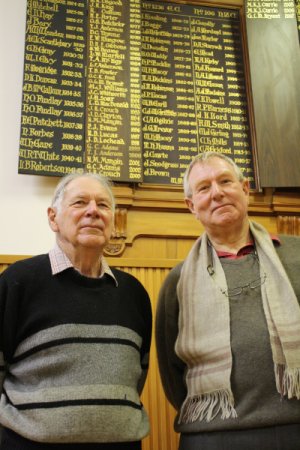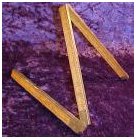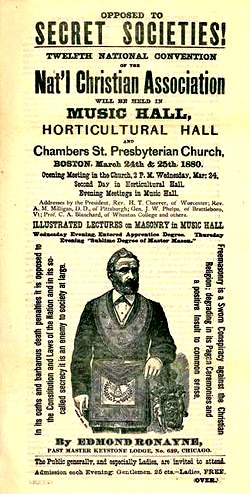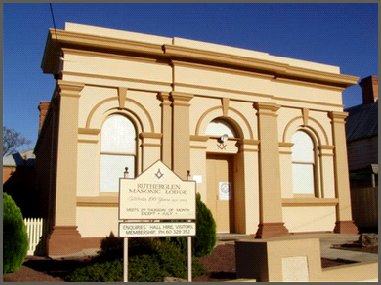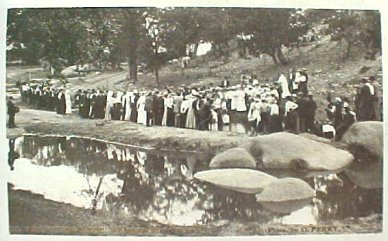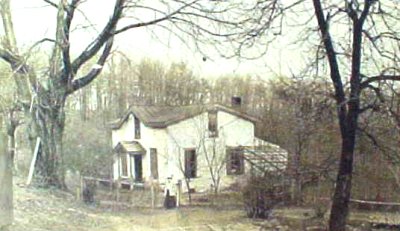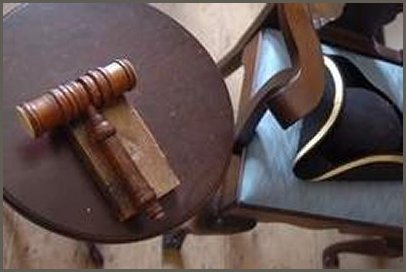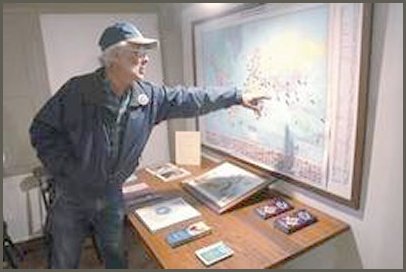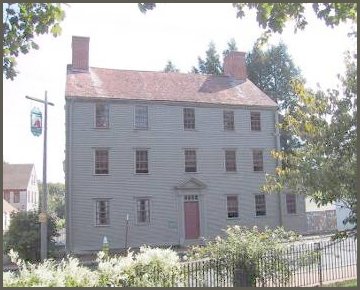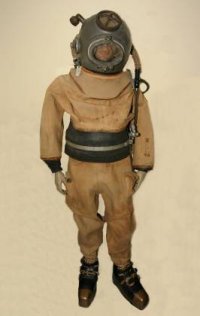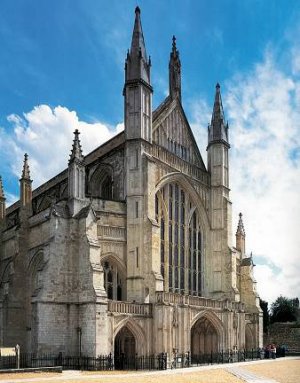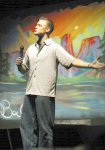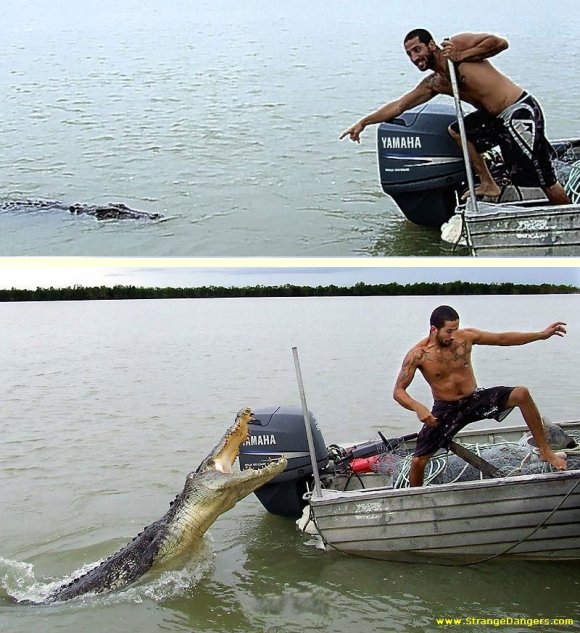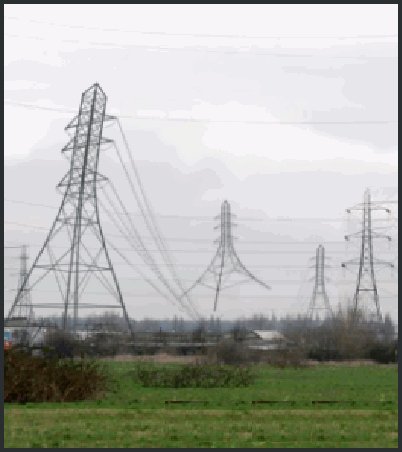
|
July 2010

Conroe Lodge No. 748, A. F. & A. M.
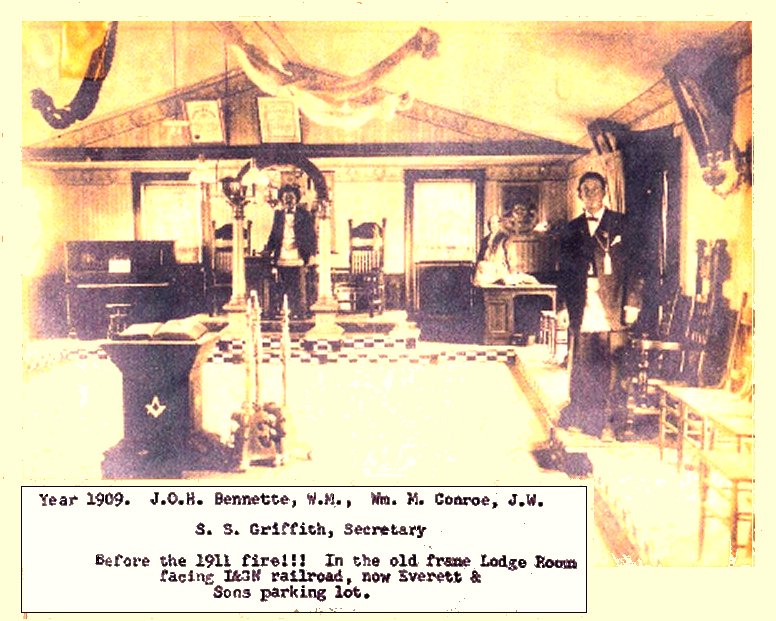 The Lodge Room in 1909, Of Conroe Lodge, in Montgomery County |
|
Page II | |||||||||
This Small Town Texas Mason's E-Magazine is not affiliated with any state Grand Lodge or individual Blue Lodge. It was created to enlighten, educate and entertain Masons and non-Masons alike. As title suggests, each issue will feature a small town Texas Masonic Lodge and some Texas Masonic history or hero in each issue The beliefs, ideas and opinions expressed here are strictly those of the authors and not necessarily those of the editor, any individual Blue Lodge or any state Grand Lodge.
A very sincere effort was made to avoid using any copyrighted material, without permission or giving credit to the author, in the creation of this web site. If you discover something that is yours, without giving you due credit, please let me know and due credit will be given or the item will be replaced.
Any material in this site may be used to increase the understanding of Freemasonry.
Story tools: |
Conroe Lodge No. 748, A. F. & A. M.
"This Issue's Visit In Texas Masonic History - Samuel May Williams.
The Birth of Free-Masonry; the Creation of a Myth Part 6 of 6
Our Brothers In Australia - The Second of Six
A Union Soldier's Masonic Book
Masons Examine 'The Lost Symbol'
36 Ways To Improve Attendance In Your Lodge
Because Time Won't Give Me Time...
The Great Secret Of Freemasontry
Mormons Off The Hook In Brown's Book
Freemasonry in Rutherglen & Rutherglen Lodge No. 188.
The Diver Who Saved A Cathedral
| ||||||||
|
Page IV | ||
|
SAMUEL MAY WILLIAMS Texas Pioneer, Businessman, and Freemason From The Grand Lodge Of Texas History Page
Samuel May Williams was the eldest child of Howell and Dorothy Williams, and was born on October 4, 1795, in Providence, Rhode Island. His father was a sea captain, and instilled a love of the sea and things nautical in young Sam Williams.
His education was in Providence, R.I., and at the age of 15 he became an apprentice to his uncle, Nathaniel F. Williams, a Baltimore commission merchant. This apprenticeship afforded him the opportunity to travel, and soon he journeyed to Buenos Aires. It was here that he mastered the Spanish language and Latin American business practice. Upon his return to the United States, he settled in New Orleans. In 1822, using an assumed name, E. Eccleston, Sam Williams went to Texas. It is unclear why he used the assumed name; some say it was because of a business deal gone bad; others say it was to escape creditors; and some say it was because of a woman – but whatever the case, Sam Williams set forth and became one of Stephen F. Austin's original "300" settlers. A year later, Samuel May Williams resumed his true identity, and became Stephen F. Austin's translator and secretary. For the next thirteen years, Williams was Austin's lieutenant; he wrote deeds, kept records, and directed colonial activities during Austin's absences. In 1826, Sam Williams was named postmaster of San Felipe and was appointed revenue collector and dispenser of stamped paper by the state of Coahuila, Mexico. For these services he received eleven leagues (49,000 acres) of land which he selected on strategic waterways including Oyster Creek and Buffalo Bayou. In 1833, Sam Williams entered into a partnership with Thomas F. McKinney and formed McKinney and Williams, a mercantile company, and they soon dominated the Brazos cotton trade. The McKinney and Williams Company Flag, and The Texas Navy FlagWilliams and Texas Independence When Texas declared independence from Mexico, the firm of McKinney and Williams used its credit in the United States to purchase arms and raise funds for Texas. As the company relied heavily on maritime commerce, both McKinney and Williams were strong supporters of a Navy for Texas. They were successful in obtaining letters of Marque and Reprisal from the newly formed Texas government (letters granting them permission to act as warships for the Texas government), and they set about immediately to arm some of their existing fleet. Sam Williams traveled to Washington DC to negotiate with the US government for a loan to allow the Republic of Texas to buy warships, and McKinney became the captain of his firm's retrofitted sailing ship "San Felipe". When Stephen F. Austin was released from Mexican prison, McKinney was dispatched to transport Austin, by sea, back to Texas. At the end of the voyage and as they approached the Texas shore, the San Felipe encountered the Mexican warship "Correo", which was attempting to capture a US merchant ship that was unloading lumber at McKinney and William's dock! McKinney was hesitant to attack the Mexican ship with Stephen F. Austin on board his ship, so Austin was put on a smaller boat and taken to shore. The San Felipe then attempted to attack the Correo. Both ships were sailing vessels and relied upon the wind for power, and the wind that day was such that neither ship could gain an advantage. They spent the rest of the day (for lack of a better way of saying it) taking pot shots at each other. The wind was no better the next morning, so one of McKinney and William's steamships, using the load of lumber from the US vessel as fuel, steamed out to the San Felipe and towed her over to an ideal attack location, and the Correo surrendered! The ship was seized and the men on board taken prisoner. McKinney was sure that the United States would try them for piracy, as they had attacked a US merchantman. The United States, however, refused to do so. When Sam Williams learned that the United States had refused to hear the case against the men of the Correo, he decided that it was time to stop negotiating for a loan to buy warships, and take positive action. He purchased the newly built "Invincible" using his own credit, and this ship became the flagship of the Texas Navy. Sam Williams thus became know as the "Father of the Texas Navy." Before the revolution was over, McKinney and Williams invested nearly $100,000 (in 1836 US dollars) in the cause of the Republic of Texas. Samuel Williams and the Republic of Texas As an investor in the Galveston City Company, Sam Williams aided in developing the city by helping to construct the Tremont Hotel as well as the commission house and wharf. In 1842, Henry Howell Williams assumed his brother's interest in the firm, which became H. H. Williams and Company, and Sam Williams concentrated on banking. Under William's leadership, the Galveston Commission house received special permission from the Texas Congress to found a bank to issue and circulate paper money as an aid to commerce. Sam Williams later ran for the United States Congress in 1846, but was unsuccessful. In 1848, Williams activated a charter he received in 1835, obtained from Coahuila and Texas and approved by the Republic of Texas in 1836, to open the Commercial and Agricultural Bank of Galveston, which also printed its own money. This venture was eventually closed because of unpopular sentiment about banking that prevailed during that time. Samuel Williams and Masonry
Although Williams is not listed as one of the original members of the Grand Lodge of Texas, it was very soon after this body's founding that he became a member. That he was not one of the original members is curious, given his history with Austin and his early work to bring Masonry to Texas. He was active in Grand Lodge, however, and served as the Grand Master of Masons in Texas in 1840. Later Life
Sam Williams lived quietly with his wife, Sarah Patterson Scott, on a country estate west of the city of Galveston. He died September 13, 1858, and was buried with a Knight Templar ceremony. He was survived by his wife and four of his nine children.
|
|
Page V | |
In the biggest of Big Pictures—the one where we seek to obtain and to propagate Strength, Wisdom, and Beauty in the world—it is important to correct such fantasies. One cannot place one's pillars on the shifting sands of Falsehood and expect them to stand.
Even on a smaller scale, it is still important to correct false notions about Freemasonry. Such fantasies get in the way of Freemasons doing their real work in the world; people hear that you're a Freemason, and (depending on the precise fantasy they hold), they either expect you to rule the world, slit their throats, or suck their brains right out of their heads like the alien celebrities on those Hulu commercials. In addition, such fantasies keep men who would be interested in the real thing from finding their way to the Western Gate. (Certainly that much has been accomplished for many men by the German Bishops' statement.)
Thus, from time to time on this blog, I shall do what I can to correct fantasies about Freemasonry. Today's entry involves the theories of a gentleman named Gary Osborn.
Mr. Osborn authors a website titled P A R A D I G M S H I F T. He recently commented on a post at another blog of mine, in which I was addressing the fact that, in The Lost Symbol, Dan Brown implies that the pyramid is an important symbol in Freemasonry (which, of course, is not true). Mr. Osborn invited the readers of my blog to look at a specific post on his website, a post titled, “The Pyramid of Washington DC and The Lost Symbol.”
There is a lot on Mr. Osborn's post. Confining myself just to what was written about Freemasonry, I encountered there a full-blown Fantasy of Freemasonry. I attempted to respond within the limits of a comment on my own blog, but there was insufficient room. In addition, if I am encountering this sort of stuff, surely many other people are as well, and there is value to responding in a full-blown post here to this sort of Fantasy About Freemasonry.
Thus, below I respond to the major points about Freemasonry that I found on Gary Osborn's post. I consider some points that are particular to what Mr. Osborn claims, and then I describe some general points that will be useful to people interested in learning about Freemasonry and evaluating what they read. My hope is that readers here will find this material useful enough to pass along to others.
Myths About George Washington and the 33rd Degree
Mr. Osborn states in his very first sentence that “As many of us know, the US Capital City is Washington DC, named after the first American President George Washington—a 33rd degree Freemason.”
Oy.
At the risk of mentioning the obvious, George Washington was never a 33rd degree Freemason. Washington died on December 14, 1799. The Supreme Council of the Scottish Rite—the body which confers the 33rd degree—was founded at Charleston, SC, on May 31, 1801, well over a year after Washington was dead and buried. The organizations that were predecessors to the Scottish Rite did not have 33 degrees. Consequently, there was no 33rd degree of Freemasonry for Washington to have received. There is certainly no evidence that I have ever seen presented to the contrary.
Why do people believe things like this? My guess is that it helps to support the Legend of the Mighty Thirty-Thirds, the myth that the holders of the 33° run the world. My sense is that there is a deep psychological need that is fulfilled by this belief—something of a pathological need, quite frankly—and the myth that the Father of our Country was one of the Mighty Thirty-Thirds helps to address that need.
The Street Layout of Washington, DC
Like many others before him, Mr. Osborn makes much of the geometry of the streets of Washington, DC. However, what he already knows about the source of this geometry should be enough to tell him not to read too much into the patterns of triangles that emerges from the layout of the DC streets.
Mr. Osborn notes, correctly, that the streets of DC radiate out from the White House and the Capitol. If one creates a street plan based around streets radiating out from two or more central points, it is inevitable that triangles of various sorts shall show up. It is geometrically unavoidable, in fact.
Masonic Involvement in the Design of Washington, DC
Mr. Osborn says that that it is “officially denied” that Jefferson and L'Enfant were Masons. This subtle choice of wording is actually quite misleading.
There is no centralized authority for Freemasonry, no central registry of all Freemasons that could issue an “official denial.” There is no Masonic equivalent of the White House Press Secretary that could issue an “official denial.” However, to state that something about Masonry has been “officially denied” is to play into the widespread and essentially paranoid fantasy that there is One Über-Lodge to Rule Them All. This simply is not so. Sure, there are various Masonic organizations that may make statements, but none of them is empowered to issue an “official denial” on behalf of Freemasonry.
For the record, neither Jefferson nor L'Enfant were Masons. People who claim otherwise should either cough up the evidence or give up the assertion. This playing about, as Mr. Osborn does, with phrases like “it's likely that so-and-so was a Mason” is just so much twaddle. As it happens, I have taught over a dozen class sections of statistics at the university level: I know from “likely.” I see no evidence to support such an assertion. On what basis is this claim of “likely” being made?
Mr. Osborn states that “there is no question that many of the new city's [that is, Washington, DC's] architects were Freemasons.” Actually, there certainly is such a question—and I am raising it. What evidence does anyone have for this assertion? Of course, the real issue is, what evidence does Mr. Osborn have that any of the people who laid out the capital city—not just any architects working in DC, but the people who actually laid out the streets of the city itself—were Masons?
The Scottish Rite, the House of the Temple, and Washington, DC
There are times, I must say, when I wish the Southern Jurisdiction of the Scottish Rite were headquartered in Baltimore, Baton Rouge, Bayonne, Brooklyn, anywhere but a mile directly north of the White House, a location that cannot but help to feed the paranoid fantasies that make the Mighty Thirty-Thirds The Rulers of The World. As it is, Mr. Osborn implies that Washington, DC, is built around the headquarters of the Southern Jurisdiction, the beautiful House of the Temple, which Mr. Osborn describes as the “Temple of Freemasonry.”
The simple fact that the Scottish Rite did not exist until 1801 should suggest that Washington, DC was not designed around, let alone at the behest of, the Scottish Rite. The city was founded in 1790. Congress held its first session in DC in November 1800. The Scottish Rite had its headquarters in Charleston, SC, when it was established in May 1801, and there it remained until 1870, when the headquarters moved to DC. The Supreme Council met at several locations until the House of the Temple was constructed, a process which lasted from 1911 to 1915, a full century after DC was laid out; DC was clearly not designed around the House of the Temple.
It is important for people to understand that the Scottish Rite is only one of several "rites" of Freemasonry, and does not run or command Freemasonry as a whole, a matter I described at length in another Dan Brown-related post. The Scottish Rite has no authority whatsoever over the Masons of the Blue Lodge, the York Rite—anyone at all except other Freemasons of the Scottish Rite (who themselves are divided into two separate Jurisdictions in the United States alone). The House of the Temple is, strictly speaking, of administrative importance only to the Southern Jurisdiction of the Scottish Rite, not even to other Scottish Rite Freemasons, let alone other Freemasons; it is lovely and impressive, but it is not the “Temple of Freemasonry.”
|
|
Page VI | |
Pyramid Symbolism and Freemasonry
Freemasonry and the Illuminati Mr. Osborn seems to lend support to those who conflate the Freemasons and the Illuminati. As I explained elsewhere on my Dan Brown-related blog, the Illuminati was a very different organization that had very different ideals than Freemasonry. In addition, although the Illuminati did infiltrate Masonic lodges on the Continent, they were unsuccessful in infiltrating Masonic lodges in either Great Britain or North America. Conflating the Masons and the Illuminati is the province of the proponents of some extremely irrational and even pathologically paranoid conspiracy theories. One would not wish to put oneself in the company of people like David Icke, Jim Marrs, or Texe Marrs. And, yes, any Gentle Reader who happens to know any of these gentlemen is welcome to quote me to him or them directly. (Messrs. Icke and Marrs: if you don't like what I have to say here, you can reach me through my home page. I would delight in debating any one of you—or all three together—in public in New York City. Three writers given to fantasy versus one who insists on evidence: I'd say that the odds favor me.) The Use of Horrifically Unreliable Sources About Freemasonry Mr. Osborn mentions the late Reverend Jim Shaw's book, The Deadly Deception, as if it were a reliable source of information about Freemasonry. The nicest thing that one can say about this book is that its late author was a fraud and a liar; my only regret in saying this is that he is no longer alive for me to say this to his face. I strongly suggest that anyone confronted by this book read Chapter 8 of the book by Arturo de Hoyos and S. Brent Morris, Is It True What They Say About Freemasonry? (New York: Evans, 2004), which is available not only through Amazon but simply off the shelf at many major bookstores; their book demonstrates that the late Rev. Shaw lied extensively about his involvement with Freemasonry. There are fine sources to use to learn about Freemasonry. I mention several of them in a basic post about Freemasonry. The sources are easy to obtain. Now it is time to step back from the specifics of Mr. Osborn's claims and consider some general principles. Basic Principle #1: We Can and Should Tell People That They Simply Don't Know Much About Freemasonry The first basic principle that comes to mind is that we should be kind, we should be gracious, but we should also be quite direct in telling people who make wildly inaccurate statements about our Fraternity that they simply do not know that much about real-life Freemasonry. Yes, I know that, in this feel-good age, that all just seems so very rude. So be it. At public and private universities in the Northeast and Southeast, I have taught literally thousands of students, many among them including future physicians, nurses, psychologists, counselors—people who will hold other people's very lives in their hands some day. I have taught them subjects like statistics, where there are right and wrong answers, and counseling, where right answers are in short supply, but wrong answers abound throughout the kingdom. I have always found that, when these people err, the most merciful way to help these people and their future patients is to tell them, nicely but extremely directly, that they are just plain wrong, and why. Freemasonry is a real set of principles with a real history. It is not just a matter of someone's opinion. (Contrary to what many people seem to believe these days, let me state quite clearly: "God was not elected. Truth is not a matter of opinion.") And yet every day there are people teaching nonsense about Freemasonry—perhaps because the process of actual study and reflection and critical thinking is so challenging. These spun fantasies become so much more rubbish obstructing the way to the Western Wall. Beyond that, every unchallenged Fantasy is another message to the youth of America and the world that The Truth Does Not Really Matter—Just Make It All Up! Not a good message to send, brethren. Remember: these are the people who will be running your nursing home and performing your surgeries some day. (Now that is a scary thought.) Basic Principle #2: Use Simple But Powerful Logical Principles to Evaluate Claims This would be a long topic by itself to handle well. For now, it will have to suffice to note that so much wild writing about Freemasonry uses weak logic, as evidenced by phrases like "there is no doubt that," or "it is likely that." By contrast, a strong thinker both presents and asks for specific evidence. In addition, as put by Carl Sagan (in paraphrasing Marcello Truzzi): Extraordinary claims require extraordinary evidence. For example: · You want to claim that so-and-so was a Freemason? Fine. Show me a dues card, a signature on a lodge register, a private diary entry or a letter where the writer claims membership. Rumors or traditions simply don't count. Yet, what we see so often in the world is that, the more outrageous the claim, the less evidence is presented. What we get instead are excuses. It's as if somehow lack of evidence was itself evidence. Well, here's a tip for all those on the fringe of the Fantasy Theories: Lack of evidence is not evidence. Lack of evidence may actually mean there is no evidence—because there is nothing to have evidence about. Lack of evidence should inspire increasing skepticism, not wide-eyed devotion. Do I sound a little cranky here? I'm sure I do. But there is a reason for crankiness like this. The older one gets, the shorter the days become, and the more one resents having to put up with nonsense. Perhaps now there will be just a little less nonsense to put up with in the world. Mr. Osborn, I hope you take this in the spirit in which it is intended. I am actually trying to help you. For if there is any bit of Masonic symbolism that should be known to the public at large, it should be this: to really make one's way in the world, one needs the light of true knowledge, not the darkness of ignorance. Not to put too fine a point on it, but statements such as you have made betray a profound ignorance of real-life Freemasonry. If you intend to connect Freemasonry to your theories, you really ought to learn a great deal more about it, from reliable sources.
[The photo of a Griffin at Kasteel de Haar, in Holland, was taken by Ellywa on 20 July 2003. It was obtained from Wikimedia Commons, and appears here by license under the Creative Commons Attribution-ShareAlike 3.0 License.] |
|
Page VII | ||||
It is not an attempt to make it seem older than it is, for an unquestionably great history does not need to be given an artificial patina. Eric Ward, Ars Quatuor Coronatorum vol. 91 (for 1978) pp. 77-86 ISBN: 0 9502001 6 6. Reprinted From The Rural Lodge Newsletter
WHAT IS FREE-MASONRY? A primary requirement of anyone seeking to bridge the gulf between the present era and the middle ages must surely be to establish that the Free-Masonry with which we are familiar today sufficiently resembles its supposed antecedent five or so centuries ago for it to be quite plain that like is being compared with like. If it be agreed that contemporary Free-Masonry possesses characteristics which make it unique amongst organized societies then any ancestral body must be shown to have possessed at least the essentials of these qualities. It is unacceptable historically merely to assert, as many writers have done, that because a particular custom is so vital and integral a part of the contemporary ritual then the same custom must have flourished amongst English medieval masons, whether or not evidence exists to prove it. It is therefore necessary to isolate some governing principle common to past and present and determine whether it has been maintained without break from the time it came to life. This is by no means simple since Free-Masonry, even in the 18th century, was not the same at the end as it was at the beginning.
It must now be apparent that the endeavour to find some yardstick by which like may be compared with like soon meets the undoubted setback that Freemasonry as it exists today is substantially different from what it was even in the early decades of the 18th century. It is true that the three grand principles remain but they are all tenets shared with other communities, especially religious ones. What then was it that distinguished the Craft before the era of symbolism? To revert to Drake's speech in 1721 the author affirmed that, according to his information, in most lodges in London and several other parts of this kingdom, a lecture on some point of geometry or architecture was to be given at every meeting. This we know to be an exaggeration but it indicates a belief by no means uncommon at the time that Free-Masonry could be identified as a system wherein the study of geometry, etc., was a declared objective, hence for instance the term 'geomatic masons' which occasionally appears. Had such technical studies been the preoccupation of those who attended lodges there would have been no need for secrecy, since the proceedings would have differed little from those of learned societies which published their transactions for all to see. However, although it is a fact that some lodges in some places held meetings at which addresses were given on architecture, archaeology and the like, the bulk of the evidence is against this kind of activity identifying the Free-Masonry of those days.
Pritchard's Masonry Dissected Bearing in mind the conditions which then obtained and the differences which divided society at large, this observation is very significant. He had expressed much the same sentiment in another way at the end of the First Charge in the 1723 Constitutions 'whereby Masonry becomes the Center of Union, and the Means of conciliating true Friendship among Persons that must have remain'd at a perpetual Distance.' The significance of these observations by Anderson, considered in the light of such other information as has survived from the initial period of Grand Lodge, is that the masonic movement c. 1717, having inherited precious little from the past, was feeling its way. As yet it possessed no very profound aims and was quite unconscious of the course that should, and in the event did, take it into a great future. In 1730 an anonymous author wrote A Defence of Masonry following publication of Prichard's exposure, Masonry Dissected. It was printed in the 1738 Constitutions and contained the definition that 'the End, the Moral and Purport of Masonry is to subdue our passions, not to do our own Will; to make a daily Progress in a laudable Art; to provide Morality, Charity, good Fellowship, good Nature and Humanity. This appears to be the Substance, let the Form or Vehicle be ever so unaccountable.' Although the author felt obliged not to account for the form or vehicle, i.e. an esoteric ritual, it was this that provided the means whereby the fundamental aims and relationships which emerged could be both preserved and enhanced irrespective of time and change. The Free and Accepted Masonry which was created independent of the building trade brought together men of widely differing views, beliefs and occupations, unified by their ready acceptance of a ritual with a moral purpose. This ritual did not have to be old, but it needed to appear so, and most importantly an element of secrecy had to be embodied. The above quotations indicate 18th century trends in he development of Free-Masonry leading to the recognition, as William Preston put it in 1775, that 'Masonry passes and is understood under two denominations, it is operative and it is speculative.' Today the same import is contained in the phrase 'We are not operative, but Free and Accepted or Speculative Masons.' The question then which now has to be faced is whether, in the whole gamut of historical records and the vast collections of medieval building accounts, there is anything to suggest that, integral with the mason trade of any period, there was a speculative element employing an esoteric ritual comparable to that which developed amongst Free and Accepted Masons during the 18th century. It must be admitted that no such evidence has been found, not even in those two famous 14th century documents written for masons and possibly by them, the Regius Poem and the Cooke MS. If English stonemasons, either in the line of duty or as a pastime, engaged in philosophic speculation they apparently left nothing to tell us about it for, although the Cooke MS. contains the word 'speculative', the meaning is that in use in the 14th century, namely the theoretical consideration of the science (of building) in contrast to the practical application of existing techniques. It does not imply symbolism, e.g. speculating on the working tools.
| ||||
|
Page VIII | ||
Another link, discussed previously, is the conspicuous absence from our records and literature relating to working masons in England of secret modes of recognition, i.e. signs, tokens and words which appear to form an inseparable part of modern speculative masonry. We cannot with confidence point to any evidence which shows that English operative freemasons made use of that kind of secrecy either as an occupational necessity or for any other purpose. EPILOGUE This paper will undoubtedly create the impression that Scotland has been given less than is due and some may even argue that no credible history of Free and Accepted Masonry could be written which so plays down Scottish involvement. The reason is that no direct link can be discerned. In the past it has been the custom of historians of the Craft to garner every fragment of documentary evidence from every part of the British Isles and form all the pieces into one homogeneous pattern of development. This implies that Free- Masonry as a philosophy was subject to growth by diffusion of ideas spread from a single authority exercising parental control. Until the premier Grand Lodge of England was established no organization or mechanism is known to have existed by which activities were coordinated in England, let alone Britain. Therefore the diffusion principle if applied before c. 1717 must, to say the least, be suspect. The spontaneous appearance in 17th century England of lodges free from the mason trade was a unique phenomenon arising out of the social conditions of the time, but of the ritual business conducted by these lodges we know very little and certainly not enough to justify thinking that they had established communications throughout the land. When in time it is possible to discern signs of a now familiar ritual, it turns out that it was substantially Scottish, of operative origin and undoubtedly borrowed. Borrowing the customs of others was itself an age-old custom and irrelevant to the age of the borrowing organization.
In the 17th century the English building trade had lost most of its medievalism in the general changing pattern of industry.
So also the vast social upheaval had prepared the ground for new institutions. Had similar conditions prevailed in Scotland
and had there been a comparable population it seems certain that independent lodges would have sprung up which would
have had no more than casual relations with their English counterparts. | ||
A Timeline of Australian Masonic History
From The Freemasons Victoria (From Our Brother In Australia)
The beginnings of Freemasonry in Australia are perhaps as clouded in mystery as its world wide beginnings. It is believed at least that the first Freemason to set foot on Australian soil arrived here with the Endeavour, in the person of Joseph Banks. Some of the important events the brought Freemasonry to Victoria are represented on this timeline.
1770 – HMS “Endeavour” reaches Australia with Freemason Joseph Banks onboard
1797 - Freemasons Arms hotel built in Parramatta
1800 27 April - Lodge of St John meets on Norfolk Island without a Warrant until 1807
1802 17 September - First Masonic document issued in Australia now held in the Mitchell Library in Sydney
1803 14th May - Masonic meeting in Sydney interrupted by military
1803 22nd May – Governor of Sydney bans Masonic meetings without his permission
1810 1st Jan – Freemason Lachlan Macquarie becomes governor of NSW
1820 12th August - Australian Social Lodge No 260 IC is the first warranted lodge resident in Australia meets for the first time.
1828 - Formation of Tasmanian Lodge No. 313 in Hobart by dispensation.
1834 22nd October - Consecration of the South Australian Lodge of Friendship No. 613 in London
1840 25th March – Lodge Australia Felix No 697 EC meets in Melbourne
1842 – Victorian John Stephen appointed Pro Grand Master for the Southern portion of Australasia
1850's to 1860's – The Gold rush in Victoria creates boom in rural population and leads to establishment of wide spread rural lodges.
1867 17th June - Royal Freemasons Homes of Victoria Established
1883 2nd July – After several failed attempts in the previous years, a Grand Lodge of Victoria is established with The Hon. George Seth Coppin as Grand Master.
1889 20th March – The remaining dissenting Lodges in Victoria join Grand Lodge forming the United Grand Lodge of Victoria.
1908 - 25 Collins Street Melbourne purchased for continued use as a dedicated Masonic hall and meeting place of Grand Lodge.
1937 17th March - New Freemasons Hospital laid in Clarendon Street property east Melbourne.
1969 – Dallas Brooks Hall opened as the New Masonic Center of Victoria
1989 – Centenary of the United Grand Lodge of Victoria celebrated.
2006 – Freemasons Hospital sold to Epworth Hospitals. |
|
Page IX | |
From the National Heritage Museum
The book once belonged to Hartwell L. Lattime of Newburyport, Massachusetts. As you can see in the photo here, he has written "Roanoke Island, Dec 13, 1862" on the inside cover and drawn the Masonic square and compasses with a G set in it, below that. On the opposite page he has written his name and hometown.
A little research reveals that Hartwell Lattime enlisted as a Private on August 24, 1862 at the age of 22. He belonged to Company A of the Massachusetts 8th Infantry Regiment. According to a history of this unit, Companies A and C of the 8th Regiment detached from the regiment and were stationed at Roanoke Island, N. C., December 4, 1862 to July 12, 1863.
The Battle of Roanoke Island was fought on February 7-8, 1862, ten months before Lattime arrived. The Union Army, after winning the battle of Roanoke Island, quickly occupied the island. Hartwell served with the Massachusetts 8th Infantry Regiment until August 7, 1863, when he and the rest of the regiment mustered out after having been ordered home on July 26, 1863.
By looking at all of the evidence above, we can conclude that it appears that just a week after his arrival at Roanoke Island, Lattime wrote the date, his location, his name, and his hometown in the book. But when did Lattime become a Mason?
According to the records at the Grand Lodge of Masons in Massachusetts, Lattime was raised and became a member of St. John's Lodge in Newburyport on November 6, 1862. At a time when there was usually a one-month delay between receiving each of the three degrees, Lattime received all three degrees in one day. By looking at the history of the regiment that Lattime belonged to, we can see that he became a Mason while still in Massachusetts, stationed at Camp Lander in Wenham, Massachusetts, just a few months after enlisting, and just a couple of weeks before the 8th Regiment boarded the steamship Mississippi in Boston on November 25, 1862 to head down to Morehead, NC. While we don't know for sure, it's possible that Lattime became a Freemason on a visit home while his company was stationed at Camp Lander where the 8th Regiment was stationed from September until late November.
Naturally, there is much more that could be explored about Lattime's time while on Roanoke Island if further research were conducted. Seeking out possible regimental histories or diaries of other soldiers stationed on Roanoke Island at the same time as Lattime would go a long way in pulling the thread that started with just a few notations that a Union soldier wrote in the front of a book one day in 1862.
As it turns out, the history of Roanoke Island after the battle in February becomes quite compelling. Lattime's time on Roanoke Island overlaps with the beginning of an interesting community that was established on the island:
"During the first few months of the Union occupation of Roanoke Island, over 250 former slaves settled in a camp close to Union headquarters. By the end of the year, the number had grown to 1,000. Most of the former slaves had escaped to the island from the North Carolina mainland; many were strangers to each other. Nevertheless, they set about to establish a thriving community, including their own school and several churches."
The quote above is from Patricia C. Click's website about the Roanoke Island Freedmen's Colony, where you can go to find more information about this interesting period in the history of Roanoke Island and the Civil War.
If you're looking or more information about Civil War regiments and soldiers, a good place to start online is the National Park Service's Civil War Soldiers & Sailors System.
Today's illustration is the inside front cover of: Webb, Thomas Smith. The Freemason's Monitor : or, Illustrations of Masonry. Boston: Abner W. Pollard ; Brown, Taggard & Chase ; Geo. C. Rand & Avery [printer], 1859.
Gift of the Lattime Family of Newburyport, Massachusetts and West Port, New York
| |
|
Page X |
By Blake From The "Masons of Texas"
The key to good attendance is simple: You must give your members a reason to WANT to come to your lodge.
Boring meetings is the single greatest reason 85% of the Masons don't attend lodge regularly. Look around the lodge tonight. How many members are present? How many total members are in the lodge? If those present represent 40% - 45% - 50% or more of your membership CONGRATULATIONS! Your lodge is doing something right! If not, a little work may be in order. The following pages list items that may help bring a few members back to the lodge, but none of them will work if it's kept a secret. You've got to let your members know what you're doing. And, don't be shy ... let them know why you're doing it. Put what you're doing in your newsletter. If you don't have a newsletter you've just discovered your First Way to Improve Attendance In Your Lodge. You can't operate in a vacuum. Your members WANT to know what is going on in the lodge. If you don't have a REGULAR newsletter the only time many members will hear from you is when you want money either for dues or for your annual campaign. Oooh ... that's not very welcoming. A phone committee can work wonders, but only if it's done regularly! 1. Make information about new members available to everyone who regularly attends lodge. Include his occupation, hobbies, interests, and reasons for joining. Record this information in a file and make it accessible to members of the lodge so when he visits they will have something to talk about. 2. Assign someone to greet each member as he enters the lodge. Make certain that he understands that it is his job to make each person feel welcome. He also introduces new members to the others in the lodge. Tonight is a great night to assign someone as a greeter at the next session. 3. The Worshipful Master and officers should be the “welcoming committee.” and be sure to shake hands with each member to the lodge. If you don't know a new member's name now is a good time to learn it. 4. Make introductions during lodge warm and personal. Every man likes to hear his name and every man wants to think people care about him and what he does. This is the first key to new friendships. 5. Include the names of new members in the newsletter. You might also consider a “Bio” of an occasional older member. Include something about him, his interests, his family and other information. 6. Insist that those who regularly attend lodge share ideas of things they would like to do, programs they would like to see, and items they would like to include. Tonight is a good night to begin asking about those things. Do it and don't take “I can't think of anything” for an answer. 7. Begin meetings on time and increase the overall pace. There is no reason that the questions asked by the Worshipful Master to the Junior and Senior Warden should be dragged out. If someone doesn't know their part it's past time to learn it. A crisp well-done opening and closing take less time and tends to be very impressive. 8. The Secretary has much to do with the pace of the meeting. If there are no petitions the Worshipful Master should be informed before the meeting and shouldn't ask if there are any to be read. If there is to be no voting, it shouldn't be asked. The same with reports. If there will be no report on the Orphanage or on the Home the Master should know these things before the meeting and not ask for them. 9. People do like to know what is going on in their fraternity. Regular reports on Oxford Orphanage and the Masonic & Eastern Star Home let the members know how their money is being spent. Insist that the chairmen of these committees keep you informed. 10.There is absolutely no substitution for planning. A good leader and good officer cares more about his lodge than to be satisfied with an informal gathering just before the meeting. He has planned a good meeting. Possibly he has invited a speaker or at least prepared a program and a presenter. To him, each night is special and he knows attendance only comes from offering your members a good “product.” 11.Older members and younger members have different expectations. Programs should satisfy both. While a program about retirement planning may be more enjoyable to the older member, the younger member will benefit also. Likewise, a program about vacation planning may not be as interesting to the older member, but older members take vacations too. 12.Whatever kind of program you present, make it the best it can possibly be. Absolutely nothing works better than quality programs to increase attendance. Every man likes to think the time he has invested in going to the lodge is worthwhile. 13.“Planning for a Perfect Evening” suggests every lodge make something special happen at stated communications at least six times each year. These meetings should be planned at least six months in advance so you can have your choice of speakers or guests. 14.Your lodge and your community is a goldmine of interesting speakers. People love to talk about what they do for a living and this can be a source of excellent speakers. But, don't surprise them. Give them time to prepare a presentation. If the person doesn't like public speaking have someone else in the lodge work with them to prepare something. A ten or fifteen minute presentation is plenty. 15.Don't forget about your District Deputy Grand Master or the Grand Lodge officers. Most can give you an interesting presentation and would enjoy visiting with the people in your lodge. 16.Almost every lodge is there at the death of a brother, but are they there when the brother gets sick or loses a relative. These can be very trying times for a brother and a card or a phone call can mean a world of difference. But, to make this effective it can't depend on chance. Assign someone to regularly check the sick list at the hospital and read ALL the obituaries noticing especially the living relatives. 17.Have you ever seen a large picture of an ostrich egg or something in the paper that made you ask why it was there? I was there to fill space because there was no news or advertising to fill the space. Take advantage of this opportunity. Whenever you have a special event either invite the newspaper or send in a picture. Let the paper decide whether to use it or not. 18.Compete with another lodge for the best percentage growth in attendance. Make the contest fun, let the losing lodge serve a meal to the winner or put on a special degree. 19.Calling every new Mason who has been raised within the past few years reminds that Mason that his lodge and his brothers are interested in him. If he hasn't attended in a while this is a good time to find out why. If there is a problem now is an ideal time to handle it.
|
|
Page XI |
Continued From Page X
20.Don't be shy. Tell them you are calling and will be calling with the intent to increase interest in the lodge. If you are sincere most brothers will tell you why the have quit attending and will want to see that you are successful in your efforts. Some may offer to help and call a few of their friends. In any event, you will have contacted a brother.
21.Take the time to look through the minutes and see when was the last time the member attended lodge. Time slips by quickly for all of us. It's not unusual for a brother to think its only been a few months and its really been several years since he attended. 22.Ask questions during your conversation to find out what has happened to his interest in Masonry. Ask open ended questions like "If there were one thing we could do to get you back interested in the lodge what would it be?" Most of the time there will be no complaints except that the meetings are boring or something to that effect. Assure him you are working on making the meetings something he will find interesting. 23.If there has been illness or a problem in the family you and your brothers need to know. It is not unusual for a brother to leave Masonry simply because his brothers ignored him during a sickness or a hospital stay and they knew nothing about it! But, is there an excuse for not knowing your brother is in the hospital? 24.Above all, don't sound like a telemarketer when you call. You are a brother who is concerned about your brother. If you are in a hurry make your calls another time. When you are finished make a notecard about the call with information you can use later or on the next call. 25.Don't scrimp on the meal. Although people will always complain about the price of a meal, most would rather pay a dollar or so more for a good one. Would you pay a dollar more for a nice cut of beef instead of a hamburger? People do it every day. The quality of the meal should come first. 26.Most of our members are more health conscious in their eating today. Heavy gravies, fat beef and lots of mashed potatoes are not as healthy as chicken and fish. Fresh vegetables are lower in sodium than canned ones. Some members have to watch what they eat and will avoid meals with items they aren't supposed to eat. 27.Ask some of the younger members to suggest some meals. They may even want to help prepare them. This is a good way to get a brother involved in the activities of the lodge. Try new foods. Every meal doesn't need to be the same. 28.Occasionally invite the wives in for the meal. This can be another one of your "special" nights. It needn't be formal, just pay a little attention to the details. You can also give a program for the ladies while the men "retire to the lodge room". 29.A lodge picnic can be a fun outing. Invite the wives, the kids, and even the neighbors. The family spirit is good for the lodge and allows the brothers to learn more about each other. Plan activities during the picnic that encourages people to work and play together. The rewards are numerous. 30.Lodge "field trips" inspire the members. Why not make a trip to the Orphanage or to the Masonic & Eastern Star Home.? Join together on a Saturday and visit points of interest throughout the state. The locations don't necessarily have to be Masonic, but it does add something extra. 31.Everyone has skills. Everyone has talents. Everyone has interests. Try to find out the skills, talents and interests of the members. Make them feel like their involvement is expected. Create a list of these items and use it in your planning. The more you can direct your lodge programs toward member interests, the more attendance you will have. 32.Be sure to listen to the members, don't just act like you are listening. Follow some of the suggestions. They may just work. If they don't, what have you lost? Remember, the lodge belongs to ALL the members and there is no such thing as an unimportant member. 33.When you develop your plan... follow it! Don't put it off. DO IT! Lodges suffer from indecision and inactivity They thrive on planning and activity, but even the best plan is no good until it is implemented. 34.Two or three people offer to help the Secretary review the minutes for the last ten years and make a list of who attended the lodge and when. From these lists isolate the members who haven't attended in the past 10 years, 5 years, and 1 year. You will be surprised. And, it may jump-start your planning. 35.Do you seriously have regular programs in your lodge or is it just hit or miss? Is there something scheduled for your first meeting night in September? What about next meeting night? What was planned for tonight other than opening, reading the minutes, this program and closing? Do you believe it's really enough to keep all your members interested? 36.Answer this question honestly. Are you doing everything you can do to make your lodge the best it can be? Source:Grand Lodge of North Carolina This article was originally published in forum thread: 36 ways to improve attendance in your lodge started by blake
|
|
Page XII | ||
Reproduced with permission from the author, "The Quaryman" From "The Work on the Trestleboard"
Lately I have been reminded of the old saying: "Those that can - do. Those that can't - teach." I started class this past week - a fifteen week Statistics course that is crammed into a six week summer session. For me this is a double whammy. Firstly, math has never been my strong point. There is a reason I went into human services - you sure as hell don't want me doing your taxes or anything else that requires more than basic math. Secondly, I haven't really been in a classroom for 20 years. Sitting in the class and looking around - I am definitely the old man in the room. The carrot is that if...no... when I pass this class it unlocks the key for me to start my Masters - a program to which I have already been accepted and which hinges on passing this class.
But alas, there is no 36" or bigger Gauge. We have been given a 24" Gauge and are taught how to use it - to keep all in proper proportion. The trick is finding out how to make it all fit into 24 hours. I think that the trouble is that we continue to try to force a bigger object into a smaller one. We cannot force 36" of length into a 24" space. Oh, we can try but eventually something gives out and sometimes it is not something that can be fixed or replaced. For instance, when I was younger, I worked myself to the bone. At one point I had three jobs and slept when occasion merited. Sure, we could pay the bills, but I missed time with my kids. See, they are all grown now - one with a family all her own - and I find myself wishing that I kept things in perspective...in proper proportion. My temple has some holes in it - I tried to fit too much into too little a space and I lost some valuable stone from time to time. I reached into my toolbox and pulled out my Gauge this week. Slowly I began to cut away some of the "vices and superfluities" of life. After next week, I will be fitting things to the 24" Gauge and I am already feeling a little relieved and more relaxed. I will spend less time doing so much for everyone else and spend a little time of those things that need my attention. I think I will start with my new grandson - after my stats homework is done, of course.
How are you applying your 24" Gauge?
| ||
Pictured on this 1880 broadside is Edmond Ronayne, a former Freemason who served as both Secretary and Master of Keystone Lodge No. 639 in Chicago. Ronayne traveled to cities across the country, performing what he said was Masonic ritual for large crowds. His intent was to "expose" and deride Freemasonry. The National Christian Association (NCA) sponsored Ronayne's lectures. Formed in 1868, this organization stated that it sought “to expose, withstand and remove Secret Societies, Freemasonry in particular, and other Anti-Christian movements in order to save the Churches of Christ from being depraved….” The NCA claimed that Freemasonry is a religion, a conclusion they drew partially from the altar, holy book, and recitation of prayers at Masonic meetings. Although Freemasonry requires that its members believe in a Supreme Being, there is no further religious test. The NCA interpreted this requirement as anti-Christian. The roots of the National Christian Association's anti-Masonic views trace back to the Morgan Affair, fifty years earlier. One of its founding members, Jonathan Blanchard, was involved in anti-Masonry as a young man in the 1830s in Vermont. (Blanchard was the first president of Wheaton College, in Illinois, whose Archives & Special Collections holds an extensive collection of National Christian Association records.) The Morgan Affair's importance to the organization persisted into the 1880s. In 1882, the NCA erected a 38-foot-tall monument to William Morgan in Morgan's hometown of Batavia, New York, where it still stands today. The broadside above advertises the 12th annual meeting of the National Christian Association, held on March 24 and 25, 1880, in Boston. A March 25, 1880, Boston Globe article described the lecture advertised in this broadside, stating that Edmond Ronayne did not meet a sympathetic audience. The crowd of about 500 people – half of whom were local Masons – reportedly interrupted Ronayne several times by hooting and hollering. The Globe reporter - who was possibly a Mason - commented that Ronayne's performance was “ridiculous” owing to his “ignorance” of Masonic ritual. Echoing other reports that his Boston audiences were less than welcoming, Ronayne wrote in his memoir that, at the March 1880 National Christian Association meeting in Boston, “the crowds in the galleries made [the] most disturbance, throwing handfuls of peas and exploding torpedoes with a loud report upon the platform.”
The broadside seen above is currently on view in Freemasonry Unmasked!: Anti-Masonic Collections in the Van Gorden-Williams Library and Archives at the National Heritage Museum.
|
|
Page XIII | ||
From The Masonic Travels
“Soon after you were here last, I learned to my mortification, my husband had become a Mason. I felt it was because of you and I need not say how I felt toward either of you. I at once decided that my domestic happiness had come to an end. Some time later a circumstance occurred that for the first time gave me reason to doubt his integrity. Late on one of the coldest nights last winter my husband came in and asked, “Margaret, can you do without your blanket shawl?” I answered yes and he asked me to get it, also a bed comforter. I handed them to him and he left the house to join a friend who was waiting for him with a very large basket. My husband returned shortly with no explanation, either then or later for his actions. I decided to watch for my shawl, for if I once caught sight of it I could unravel this whole mystery. Soon afterward a female whisked past me on the street wearing my shawl.
“The good for nothing huzzy, I thought; and excitedly started in pursuit. I followed closely from street to street and into the fourth story of a bindery. As she sat down to work I immediately set about locating her residence to get a clue to my husband's perfidy. On arriving at her home I saw that I was not mistaken for I found my comforter there.
“But the grand secret of Masonry,” said I, “I thought you were to tell me what it is.”
She replied, “It is this—to do good and not tell of it.”
| ||
|
Page XIV | |
Richard Stradling, Staff Writer By Peggy Fletcher Stack The Salt Lake Tribune
Faith and fiction » Novel notes LDS Church only twice, but major theme echoes key doctrine.
Worse, they thought, he would expose and possibly caricature their closed-door temple rituals. But, it turns out, Brown mentions The Church of Jesus Christ of Latter-day Saints only twice in his 509-page book. The first reference mentions LDS history as an example of religious teachings that don't hold up to "scientific scrutiny." Then, late in the book, he adds the Mormon practice of baptism for the dead (which he calls "baptism of the dead") to a list of practices that could seem weird if taken out of context. However, one of Brown's major themes -- that human beings have the potential to be gods -- echoes Mormon teachings. "That should resonate with Latter-day Saints," says Mark Koltko-Rivera of New York City, a Mormon high priest and Master Mason. "I know this is our doctrine that causes the most trouble with other Christian churches. But it is a central belief that we should be more open about and celebrate." It would have made fictional sense for Brown, who visited several Utah LDS and Masonic sites in 2006, to create a Mormon character as his anti-Masonic foil. After all, antagonism between the two groups goes back a long way and often was contentious, even violent. In the 1840s, many LDS leaders, including church founder Joseph Smith and apostles Brigham Young and Heber C. Kimball, became Masons and organized a Nauvoo Lodge under the auspices of the Grand Lodge of Illinois. It wasn't long before nearly every male Mormon in the area had joined. At the same time, Smith introduced LDS temple rituals that included secret handshakes, signs and symbols like the all-seeing eye, the compass and square (tools of the mason's trade) along with the sun, moon and stars that paralleled Masonry. Soon, other Masons felt that the Mormons were dominating the fraternity. The Nauvoo Lodge was suspended in 1842. Many Mormons believed that Masons contributed to the murder of their prophet June 27, 1844. Smith reportedly began to utter the Masonic distress call, "O Lord, my God, is there no help for the widow's son?" as he fell to his death from a second-story window after being shot by a mob. In 1859, a Masonic lodge was established by Johnston's Army at Utah's Camp Floyd, but it didn't accept Mormon candidates. At the same time, Young forbade Mormons from joining and refused to allow any Mason to hold priesthood leadership positions in the church. It wasn't until 1984 that LDS President Spencer W. Kimball removed the prohibition against Latter-day Saints becoming Freemasons. Later that year, the Grand Lodge of Utah discontinued its own ban on Mormon membership so that, in the ensuing years, many LDS men have returned to this part of their heritage. In 2006, Glen Cook became the first Mormon to serve as the state's Grand Master. Some people suggest that Smith copied Masonic rituals for his LDS temple, but Koltko-Rivera thinks that's too simplistic. Instead, he says, it was just the trigger for Smith's divine inquiries. "Masonry prepared Smith for a vision of the Latter-day Saint endowment," Koltko-Rivera says. "The two ceremonies are complementary. Both are fascinating but in very, very different ways."
The LDS endowment is about exaltation in the hereafter, he says. "The Masonic ritual is about being a good, good person here." | |
|
Page XV |
Story Reprinted With Permission Of Dr. Roger M Firestone
Editor's Note; I have written a few rebutals about anti-masononry myself, but nothin that I love as much as Dr. Roger M Firestone's reply. In response to an outsider who intruded into a Masonic online Forum. Dave Pope complains that Masons are not always overflowing with brotherly love and tolerance. Unfortunately, his context is perhaps not a fair measure of things. Suppose, Mr. Pope, that an aluminum siding salesman came to your brick home and proceeded to inform you of the benefits of aluminum siding day and night, without regard to the fact that brick homes need no such siding, and repeated himself endlessly and refused to leave your living room to allow you to discuss subjects there that interested you. Wouldn't you, at some point, lose your Christian virtue of patience and hustle him bodily from your home? Notwithstanding his sincere desire to sell you something that he himself has benefited from and in which he believes most thoroughly? And suppose he was part of a team of eight aluminum siding salesmen who came to your house in rotation? All wanting to do you good, no matter how inappropriate to your personal situation? How much patience has even a saint? In short, Mr. Pope, that is what you and your sincere, fundamentalist friends are doing here. You have read the Bible, and developed your own (or more likely accepted your religious leader's) interpretation of it, and you have read one or two books about Freemasonry, written by outsiders who may well have an ulterior motive (such as making money by selling books) but have a serious lack of knowledge and understanding about Freemasonry, whether from ignorance or malice. You are as convinced that we need your particular vision and version of religion, just as much as that siding salesman is convinced that everyone needs aluminum siding. People who live in brick houses don't need aluminum siding, and sincere, religious, church- (or synagogue- or mosque-) going Freemasons don't need a new religion. But you won't take "No" for an answer, and you won't listen to reason when we explain that Masonry is not pagan, not Satanic, not anti-Christian, not a religion, not any of the things you claim it is. And you aren't the only one. We have heard from a dozen or more people like you this year alone. And you have the same arguments as they do, because you have read the same three books (by Texe Marr, or whomever) that quote the same passages from Pike out of context, and repeat the Taxil hoax, and mumble the same foolishness about five-pointed star, and on and on, ad nauseam. And they won't go away and leave us alone until they have thoroughly exhausted our tolerance as we wearily beat into them the same arguments and explanations and refutations over and over again, and they finally learn that we know more about Masonry than they ever will, and we can't be persuaded by their fictions and distortions. That is why, Mr. Pope, you seem to feel put upon by some of the responses you get in this newsgroup and by private email. You are an unwelcome salesman, selling inappropriate and unwanted goods, sitting in our living room and making our lives unpleasant. To behave like that and then complain about our behavior towards you takes a certain amount of gall. But I have a feeling that even this lengthy (and, I believe, polite and temperately-phrased) explanation of why you are the target of abuse is not going to get through to you. So please tell me where you live; I know of an aluminum siding company that would be interested in talking to you…
Roger M Firestone, 32 KCCH
|
|
Page XVI | ||||
By Worshipful Brother Steve, Past Master of Rutherglen Lodge
Rutherglen's first Masonic Loge was formed in 1865 and folded in 1884. It was known as the Alexandra Lodge and was No. 1115 in the English Constitution. As mining declined in the area, so did the numbers in of lodges in the North East of Victoria, hence the demise of the Alexandra Lodge. Rutherglen Lodge (No. 188 VC) held its first meeting on July 31st 1902 when the minute book states that the ceremony was “the dedication of the Masonic Hall at Rutherglen and of the consecration etc. of the Rutherglen Masonic Lodge No 188". The ceremony also included the Installation of the first W.M. and other business of the first meeting of the Lodge. Wor. Bro. S.P. Gollings was our first official D.C. He served from 1905-1906, 1908, and 1919-1931. The Director of Ceremonies Baton that is still in use today was donated by the same Individual. The D.C.s pedestal on which the same sits was donated by Bro. T Robins. In July 1931 it was moved that the words “Thursday on or after the full moon” be deleted from By-Law Number 2 and that the words “second Thursday” be inserted. This was carried unanimously. In 1938 the Lodge equipped a Ward in the newly built Rutherglen Bush Nursing Hospital. In March 1945 it was decided to have a 'Ladies Night' and two of the younger members moved that Non-Masonic friends be also invited. This motion was defeated. (It seems that the younger members don't often win the day so nothing has changed. LOL) In 1957 the Past Master's Jewel was presented for the first time. This is the same Jewel which the brethren presented to J.H. Kilgour, the first I.P.M. of Rutherglen Lodge. Upon his death in 1946 the Jewel was left to Wor. Bro. Norman Wright of Hampton Lodge and was to revert to Rutherglen Lodge upon his passing. When he died in 1954 the Jewel was given to his daughter, Mrs Jean Marks who was married to Dr. H.A. Marks of Wangaratta. In 1957, after a chance meeting with Wor. Bro. Norm Killeen the Jewel was given to him to present to the Lodge which he subsequently did. This is now a perpetual Past Master's Jewel which has been worn with great pride by a succession of Past Masters from our Lodge. Rutherglen has had five Father and Sons as Masters. In 1988, Rt. Wor. Bro. Sonny Downs presented the Lodge with a hand written summons to the first meeting of Alexandra Lodge sent by Bro. Ninian Bow, and an original copy of its By-Laws. The summons is displayed on the Secretary's table. In March 1999 the facade of the Lodge was painted in Heritage Colours at a cost of $1,700. Subsequently the Lodge received a Heritage Award Certificate for the same from the Indigo Shire. Sharing Memories. Riding the Goat. Perhaps one of the most amusing anecdotes occurred one night after the meeting when the brethren were in the South enjoying themselves. At the time the block behind the lodge was overgrown with grass. A local woman had asked if she could put her goat in the yard, thereby providing it with pasturage and at the same time removing the fire hazard for the lodge. Anyway, this night, several of the brethren, including the then Wor. Bro. Sonny Downs, feeling that the evening needed livening up went out, and captured the aforementioned creature, (which was probably more interested in getting some sleep rather than being called from refreshment to labour). One Worshipful Brother then hopped astride the goat and walked it into the South and did a couple of laps round the room much to the amusement of all present and giving a whole new meaning to the term “Goat-Riders”.
In July 2002 I had the pleasure and honour of being installed as the Centenary Master of Rutherglen Lodge. To honour the occasion, the Lodge produced a history of the Lodge which was distributed amongst those interested for the princely sum of $5. Also on the day of Installation a Re-Consecration Ceremony was held and Ladies and non-Freemasons were admitted to the Installation of officers for the first time in the North-East.
| ||||
Willow Lodge No. 746 - Willow City, Texas 1893 – 1924
According to the Grand Lodge returns from Willow Lodge, the Lodge met on Saturday night on or before the full moon in each month. This fact, along with other Grand Lodge records, seems to be the only written information available regarding the activities of Willow Lodge. In an effort to uncover more of the Lodge's history, a visit with several of the town's residents took place in early 2003. Based on interviews with local residents who were living in Willow City during the mid-twentieth century, the Masonic Lodge was first located in a building near the banks of Willow Creek, where the town of Willow Creek was situated. The Lodge building was also used as a church where two different denominations held services. In the late 1890s a flood destroyed the building along with most of the rest of the settlement of Willow City, or as it was known then, Willow Creek.
A new Masonic Lodge building was constructed at the southeast corner of Highway 1323 and Willow City Loop on a City lot owned by J. R. Robinson, Secretary of Willow Lodge at the time, in the "new" town of Willow City which was moved some one quarter of a mile away from Willow Creek. According to local residents who were living in Willow City at the time, sometime during the 1940s or 50s the Lodge building was nearly completely destroyed when a milk truck failed to negotiate the sharp turn where the Lodge building was located and crashed into the building. The building was later demolished and the lumber used in other building projects in Willow City. It is reported that a number of Masonic artifacts and regalia were taken from the building during demolition and are now in the hands of a current Willow City resident. Efforts to document the existence of these artifacts continue to this day with the hope that new light will be shed on the history of Willow Lodge. The City lot where the last Masonic Lodge building once stood-is now owned by Calvin Hohmann, who confirmed the location and destruction of the "new" Willow Lodge.
From the book, “Freemasonry In Gillespie County”, part of a research paper presented to Texas Lodge of Research Grand Lodge of Texas March 2007 by James Murdock McCrae Past Master, Fredericksburg No. 794 A.F.& A.M.
|
|
Page XVII | ||||
With membership down, centuries-old fraternal order opens doors, dispels myths In New Hampshire
By Charles McMahon
The men of the Freemasons represent a community veiled by secrecy, but united by a common goal. Long misunderstood and often unacknowledged, the Freemasons are among the oldest and largest fraternal organizations in the world, and members are responsible for acts of charity ranging from painting the fences of community graveyards to contributing millions of dollars in philanthropy each day. Freemason lodges from all over New Hampshire recently opened their doors for all eyes to see in an effort to rid the shadow that they say has enveloped the men's society for centuries. Today, there are about 7,250 active Masons representing 70 lodges spread throughout New Hampshire. Freemasonry's roots can be found throughout the Granite State, most notably in the Seacoast, and especially in Portsmouth. "The history of Freemasons here in New Hampshire dates back quite a ways," said the Right Worshipful William Sawyer of the 1st District. Freemasonry traces its official history to the formation of the Grand Lodge of England in 1717, but is generally regarded to have evolved from the cathedral builders of the 1400s and their proprietary system of stone mason guilds. Sawyer said Freemasonry popped up in Portsmouth exactly 19 years after the Grand Lodge in England was formed. Established on 24 June 1736, the local Mason society known as St. John's Lodge No. 1 is the oldest continuously active lodge in North and South America, said Sawyer, who serves as chairman of the Public Awareness Committee. Having held more than 6,000 meetings since its inception, the local lodge holds some of the oldest and complete Masonic records of any in the country, he said. The meetings that take place behind closed doors are anything but secret, Sawyer said. There are two types. In a "stated meeting," which is conducted on a monthly basis, Masons work on business-related matters and approve minutes and issue reports. Sawyer said the meetings involve all the "mechanical things of Masonry." The other type — a "special meeting" — involves the master of the lodge calling Masons to meet aside from normal operations and routinely involves working with a candidate as they pass steps known as "degrees," he said. Members aim to achieve three degrees, starting with Entered Apprentice, Fellowcraft and Master Mason. Sawyer said compared to Masons of the past, known as "Operative Masons," today's Mason is known as a "Speculative Mason," meaning they no longer work with stone. "We don't work with stone. We have other ways to teach people rather than through my mouth to your ear," he said. Sawyer said beyond that, Masons have many other groups they can join that are affiliated with Freemasonry, but follow their own rank and order structure. Lodge members are required to pay annual dues. Sawyer said lodges determine their own dues, and the cost for a Mason to be part of the St. John's Lodge is $75 per year. Over time, meeting places or "lodges" for Masons have ranged from members' homes to local taverns, Sawyer said. Perhaps one of the most notable and historically significant meeting places is the William Pitt Tavern in Strawbery Banke. John Stavers, a member of St. John's Masonic Lodge, built the tavern in 1766. St. John's held regular meetings at the tavern almost from the time it first opened. The entire third floor served as a lodge room, and in 1789, the Masons founded the Grand Lodge of New Hampshire there. Today, the William Pitt Tavern serves essentially as a museum, but still is used for official Mason business from time to time. The three-story tavern contains many artifacts, pictures, paintings and pieces of literature.
Today, masons call the Masonic Temple on Middle Street their home. Rumors of secrecy have followed the Freemasons for centuries. Stories involving Masons taking part in dark rituals or controlling the government have become infamous thanks to the works of many, including local author Dan Brown, who wrote such best sellers as "The Davinci Code" and "Angels & Demons." Moulton said meetings are often misconstrued as secret, when the term private would be more appropriate. "There is a great deal of difference between secrecy and privacy," he said. Freemasons, according to Moulton, are required to believe in a supreme being. Discussion of politics or religion while conducting Mason business is prohibited and carries penalties, however."Discussion of that is left outside the door," said Moulton. "It divides people." Worshipful Tom Haslam, presiding Master of the St. John's Lodge, said meetings can vary from routine topics such as business and charitable decisions to the initiation of new members. Haslam said aside from business and social time, Masons immerse themselves in charitable efforts that range from road races to fundraisers. "We try to have fun, but we also try to help people and we try to improve ourselves as well," Haslam said. The society currently is inducting many new members, but the road to Freemasonry is not something offered or simply handed out. "Technically to become a mason you have to ask to become one, we don't actively go out and look for people," he said. Haslam said when someone comes to the society and asks to become a member, they are always asked why. Eighty percent of the time, he said, the answer is because they want to give something back to the community. Giving back, making friends and learning more about the history of Freemasons are just some of the many reasons people want to join, he said.
|
|
Page XVIII | ||
|
"All of this has made people aware of the fact that there is an organization," he said. Perhaps the best and most notable thing Freemasons have done, he added, is ensured nobody knew what it was about. "It's very difficult to make an organization grow when you don't tell anyone what you do," he said. "That's the one thing we did very well." But times are changing, he said, and Mason society has recognized that by shadowing itself from society, negative connotations seem to follow. Libby said Masons today are the same men who write laws, enforce them, fight fires and treat sickness.
Regardless of secret handshakes, sacred symbols, ceremonial garb and rituals, the Masons maintain the primary mission of their society is not to deceive or trick, but rather to help and educate. Together with their most famous extension, the Shriners, and other facets, Freemasons help fund anti-drug programs, nursing homes, local charity events, reading programs, aid for child burn victims and more. The actual amount contributed daily to charities, according to Sawyer, is in the range of $2.5 million nationally.
Despite reports of membership being low, that still doesn't' take away from the fact that the Masons are the world's largest and oldest fraternal organization, Sawyer said. The last time the society was at its peak in terms of membership, according to Sawyer, was around the end of World War II, when soldiers coming home to families sought a common bond. "There are peaks and valleys," he said. Still, with more than 3 million Masons worldwide, Sawyer said the reason for the drop in numbers over the years is because the men who joined in the 1950s are getting older and dying, while potential new members can choose from many organizations such as the Rotary and Kiwanis clubs.
Sawyer acknowledges that the reasons men join the club vary, but he offered his own experience as an example. As a young man, he said, he took part in a facet of Masonry for young adults known as the Order of the Demolay. It was there that he said he was able to develop concepts and beliefs similar to Masons that led him throughout his life. "That's how I got my first inkling of what Masonry could be," he said.
Once he was too old to take part in the youth group, he said his interest and involvement remained, but it wasn't until nearly 15 years ago that he began asking the questions that would lead him to being the Mason he is today. He said he was chatting with a colleague at the bank where he works and noticed the man had a Masonic ring on his finger. From there, he said, he engrossed himself in the organization and has pledged his devotion to the mission. "We are a group of people that band together with a common interest to help and support and come together as friends and neighbors and a community," he said. "While the meetings we hold are closed to the public, the work we do is wide open."
In 2011, local Masons will band together to celebrate the 275th anniversary. Plans are in place for a celebration, and a specialized Christmas ornament is available for sale
| ||
From the Rural Masonic Lodge Newsletter
It might seem strange that this huge medieval edifice, firmly rooted on terra firma was helped by a diver, but such was the case.
Bro William Robert Walker (1869-1918) was a member of the Royal Jubilee Lodge.
In 1892 Walker left the navy to become an employee of the pioneering diving firm Siebe Gorman & Co. of London. He worked for four years in Gibraltar on the new dockyard, and was in constant demand to deal with flooded coal and lead mines, and to undertake wreck work. He participated in experiments for his firm, whose doctors were collaborating with Admiralty physicians on the subject of underwater pressure, and he made a near record dive to 189 feet.
Walker was working on a new jetty at the Victoria docks, London, when he was sent to Winchester Cathedral for the five-year project for which he was to achieve national fame.
Walker quickly achieved popular renown as the key figure in the preservation operation at Winchester, in which up to 150 other workmen were involved. He worked for two four-hour shifts a day, which allowed time for two three-hour periods under water. There, in almost total darkness caused by the turbidity of the water, Walker worked at a depth of some 15-20 feet, completing the excavation of the drifts, and laying two to three layers of bags of cement concrete, which sealed the ingress of water from below. It was then possible to pump out the drift so that masons could complete the underpinning. Eventually the foundations of all the outer walls of the cathedral were renewed in this way.
Walker's work at Winchester was completed by August 1911. On 15 July 1912, St Swithun's day, the preservation works were commemorated by a service of national thanksgiving, attended by the king and queen. Walker was present at the service and was presented to King George V after the service. His former pupil congratulated him 'upon [his] feat in saving the Cathedral' At the end of 1912 Walker was made a member of the Royal Victorian Order, an honor in the gift of the sovereign.
Walker was a robust man. His job required considerable stamina, and he scarcely lost a day's work through ill health, attributing this to the pipe which he regularly smoked in silence between shifts, claiming that it preserved him from the harmful effects of working in ground then considered to be infected by 900-year-old graves. He returned each weekend to his family home near London, on one occasion making the journey by bicycle. A modest man, he spoke little about his exploits, despite constant media attention.
In 1918 Walker fell victim to the worldwide influenza epidemic. In 1964 a statuette of a diver by Sir Charles Wheeler was unveiled in Winchester Cathedral in honor of the man who had 'saved the cathedral with his own two hands'. In 1989 Walker's neglected grave was restored by public subscription. In June 2001 a bronze portrait bust of Walker by Glyn Williams was unveiled. Walker is remembered annually at Winchester.
|
|
Page XIX | |
|
By blake
It was an age of expanding horizons and increasing vision, of strident revolution, mighty nations, and even mightier conflicts was also the time of a remarkable demonstration of Masonic diligence and fraternal toleration to an unheard of degree.
During the Seven Years War and the Napoleonic Wars (1740 to 1814), approximately 200,000 members of the French Army were taken prisoner and held in captivity in England. Not all of these prisoners were French, although they were members of the French Army. How many Poles, Germans, Italians, and Spaniards there were in this group cannot be said, but there must have been a considerable number. As a guide, one might use the half million men that Napoleon led into Russia in the abortive campaign of 1812. On ly 200,000 of these soldiers were French. In view of this, the Masonic diligence they displayed takes on an interesting international tinge.
About 50,000 of the war captives were held in Britain in eight principal land prisons; the rest were incarcerated in prison ships that were literally floating coffins. The officers among the ship-bound prisoners were considered in a category separate from the others. Those who would give their parole were allowed to live in one of the designated 'parole towns.' They received a weekly allowance from the British Government of a half-guinea, about $1.50 at today's rate of exchange. This allowance, it should be understood, was given only to those who would give their parole. The rest got nothing, bad food, rags for clothing, pestilence and chains.
No one ever took the pains to record just how many of the prisoners were Masons, but there must have been a great many and of considerable dedication. In the eight land prisons they established five Lodges; in the 50 parole towns, 32 Lodges; and, impossible as it may be to conceive, in the 51 prison hulks, where anything like a normal life was virtually if not completely impossible, there were six Lodges established.
It should be understood that these were not casual or occasional meetings of men belonging to the Craft, but, within the limitations of time and facilities, properly established Bodies, although generally without warrants. They conducted regular stated meetings with a full list of officers and a code of by-laws. They kept accurate and complete minutes of their meetings, many of which are preserved to this day.
That this was not only condoned but even encouraged by British brethren is attested by many recorded facts. At least four of these Lodges, (Ashby, Chesterfield, Leek, and Northampton), applied for and received permits from the Acting Grand Master of the Grand Lodge of England, although they did their work in association with the Grand Orient of France. Rites practiced generally were the Rite Francaise ou Moderne, adopted by the Grand Orient of France in 1786. It featured seven degrees, the first three the same as those we practice today, the upper four in ascending order being Elect, Scotch Master, Knight of the East, and Rose Croix. To add variety to the picture, some of the certificates given by these Lodges were signed in the Eleventh Degree of the Adonhiramite Rite. That the Craft could even think of a Lodge meeting under the stultifying conditions of the prison ships is almost incredible, but they did. In fact, one brother left a description of a Lodge meeting he visited on one of the hulks, the Guilford, anchored in Portsmouth harbor. This visiting brother was named Lardier.
He visited this meeting under the sponsorship of two other brothers, whom he refers to as 'Children of the True Light.' They traversed the whole length of a lower deck without illumination. Then they reached a trapdoor which was raised by another brother so they might descend a short, rotten ladder to a still lower, still darker deck.
In this situation he was led through complete darkness by sure hands until they were confronted by a man who demanded the password, signs, and grips. Having satisfactorily met this challenge, they crawled through a small door into a cramped room, where the ceiling was so low that they could not stand erect. Illumination of the 'hall' was by means of a candle mounted in an old bottle. Only the Master was provided with a seat, and this was a dilapidated bench from which one leg was broken. The rest of the brethren sat on the floor. Here the visitor saw a candidate put through one of the degrees.
He remarked: "Physical examination and much of the ritual were impossible because of the cramped quarters but the candidate was rigorously tested from the moral viewpoint, especially in matter of patriotism."
The Master's speech, which was also a prayer, went;
"Thy children cannot close these labors without expressing their grief and rendering homage to Thee. My heart is not captive, it is still free and faithful, it lifts itself out of this place of bondage and speeds to the land that gave it birth. May the glory of Thy triumphs never fade, may the Hero who guides Thy Chosen be able to add the last and only jewel which is wanting in Thy crown . . . by utterly destroying that odious rival which dares to contend with Thee for mastery of the world."
These words are living proof of the indestructible spirit of the faithful Craftsmen who met in that dark room in the belly of the prison ship. This remarkable meeting closed with a voluntary offering for the relief of others more distressed than themselves. What can men give who have nothing for themselves? No one knows, but give they did and records amply show that the generosity of these half-starved half-clothed shadows of what were once men gave not only for needy brethren but for all prisoners whose need was greater than theirs. Was there ever a more perfect ashlar for that symbolic temple?
Where did they get anything to give? Again, no one can say, but it is known that they made and sold art trinkets of magnificent craftsmanship. This undoubtedly was a part of their source of income. Truly marvelously contrived medallions constructed by these unfortunate brothers are still on display in the great Freemason's Hall off Drury Lane in London.
Forty-four certificates issued by these Lodges have been discovered. These beautifully lettered documents, with a seal of wax from specially cut dies enclosed in a tin box, ribboned as documents of the day often were, are each a work of art in itself. The wonder is not that they spent the time and effort to make them so notable, but that the wretched prisoners on the comfortless and pestilential prison hulks were able to procure the necessary items for their fabrication.
Considering the words of the Guilford Master quoted earlier, and in view of the centuries of bitter French-English rivalry and war, it would seem unlikely that even Masonry could cross so insurmountable a barrier, but it did. It is reported that a Brother Burnes, who was magistrate and Master of the British Lodge at Montrose, actually released French prisoners from jail as a fraternal gesture.
The minutes of many British Lodges show that French parolees were frequently received as welcome visitors and in many cases became joining members. As has been noted earlier, at least four Lodges among French prisoners were sanctioned by English Grand Lodge warrants. Most of the French Prisoner-of-War Lodges restricted themselves to French members, but in at least three Lodges (Abergevenny, Launceston, and Wincanton), Englishmen applied for membership and were accepted and initiated.
An interesting sidelight occurs through the fact that under French Masonic rules, seven Master Masons in a town where there was no Lodge or twenty-one in a town where a Lodge already existed, could hold a meeting and elect officers. Thus, at Peebles, in 1811, French prisoners established and operated a Lodge. The local British Lodge made no objection to this until it was discovered that the prisoners' Lodge was initiating new members. They objected to the Grand Lodge of England on the grounds that their own properly constituted Lodge was adequate to the occasion. The Grand Lodge agreed, but the prisoner-Masons, operating under their own French rules, disagreed. Records of this disagreement are to be found in several references, but only one makes further comment, and he notes rather cryptically that there is no record that the prisoners' Masonic work was discontinued.
To complete the picture, it is not only necessary but fitting to point out that during this same period of time approximately 25,000 English soldiers were taken prisoner by the French. Once again, it is impossible to say how many of these men were Masons. However, in a detachment of the British 9th Regiment of Foot that was captured and confined, there was a regularly constituted travelling Military Lodge No. 183, "Antients." This Lodge met regularly in prison, the fortress of Valenciennes, until 1814. T he minutes of its meetings have been preserved.
Today, as we sit in our comfortable halls with all the treasured implements of our moral labours about us, it is difficult to conceive of the difficulties under which our imprisoned brethren struggled to maintain and demonstrate their fraternal fidelity, but not at all difficult to understand. Masonry to them was far more than a fraternal link; it was a vital and living key to continued existence.
As a final note, it should not be thought that this small section of history is merely a record in the archives or, for that matter, only another demonstration of the way Masonry raises a man above himself. It is still a subject for discussion and comment. As late as 1913 a pamphlet was published in Paris, accusing French Freemasons of assisting their imprisoned British brethren to escape. At this late date, firm proof for or against this assertion is impossible to find. However, from the evidence at hand, it would appear quite likely that the accusation is gloriously and wonderfully true.
Source: Robert M. Walker 32 degree
This article was originally published in forum thread: Masons as Prisoners of War started by blake View original post
|
|
Page XX | |||||
Beever gives his drawings an anamorphosis view, his images are drawn in such a way which gives them three dimensionality when viewing from the correct angle. It's amazing !!!
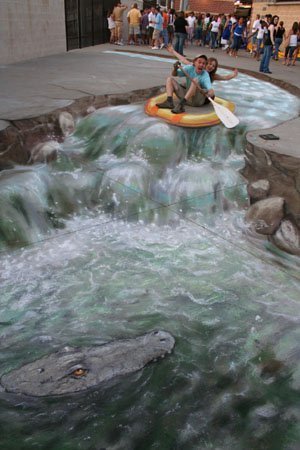 Drawn On A Flat Sidewalk With Colored Chalk.
Garbage Trucks
One day I hopped in a taxi and we took off for the airport.
We were driving in the right lane when suddenly a black car scooted out of a parking space right in front of us.
My taxi driver slammed on his brakes, skidded, and missed the other
car by just inches! The driver of the other car whipped his head
around and started yelling at us.
My taxi driver just smiled and waved at the guy.
And I mean, he was really friendly.
So I asked, 'Why did you just do that?
This guy almost ruined your car and sent us to the hospital!'
He explained that many people are like garbage trucks.
They run around full of garbage, full of frustration,
full of anger, and full of disappointment.
As their garbage piles up, they need a place
to dump it and sometimes they'll dump it on you.
Don't take it personally.
Just smile, wave, wish them well, and move on.
Don't take their garbage and spread it
to other people at work, at home, or on the streets.
Successful people don’t let garbage trucks take over their day.
|
|
All material in this site may be used to educate everyone, Freemasons and non-Freemasons alike about Freemasonry and for the promotion of Freemasonry. A very sincere effort is made to avoid using any copyrighted material, without permission or giving credit to the author and source, in the creation of this web site. If you discover something that is yours, without giving you due credit, please let me know and due credit will be given or the item will be replaced.
|
|
|

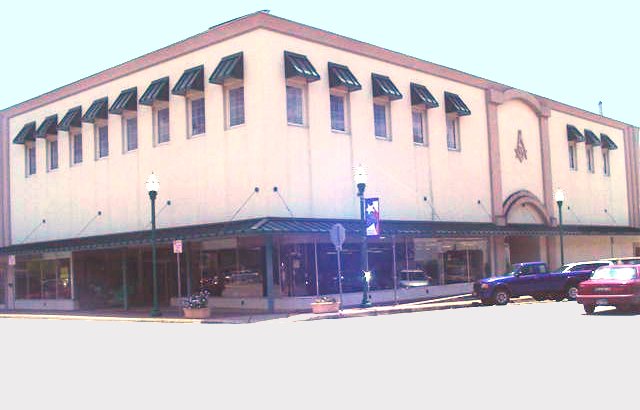
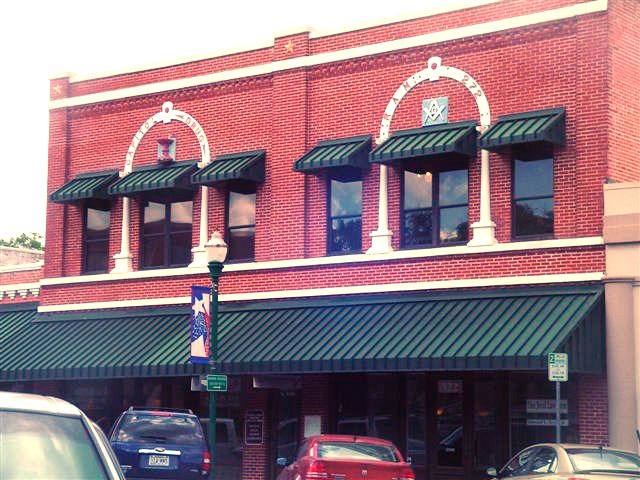

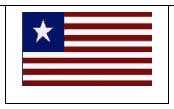
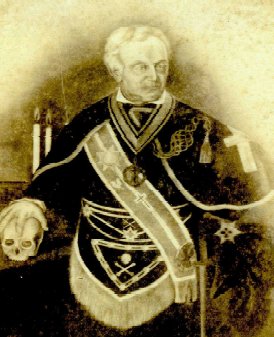
 By Mark E. Koltko-Rivera
By Mark E. Koltko-Rivera